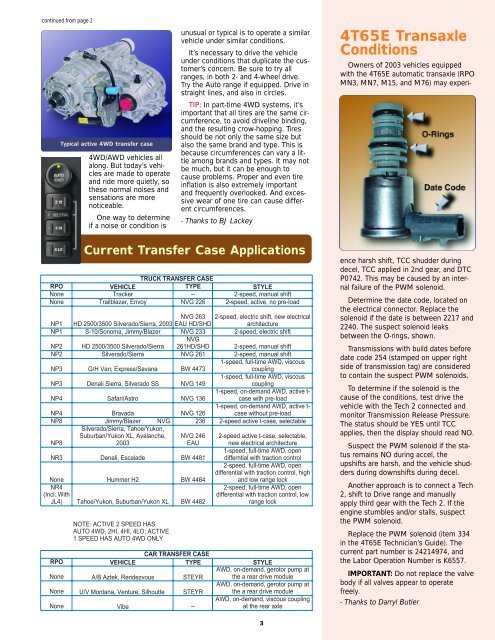All-Wheel Drive and 4-Wheel Drive - Vehicles we focus on
All-Wheel Drive and 4-Wheel Drive - Vehicles we focus on
All-Wheel Drive and 4-Wheel Drive - Vehicles we focus on
You also want an ePaper? Increase the reach of your titles
YUMPU automatically turns print PDFs into web optimized ePapers that Google loves.
c<strong>on</strong>tinued from page 2<br />
Typical active 4WD transfer case<br />
4WD/AWD vehicles all<br />
al<strong>on</strong>g. But today’s vehicles<br />
are made to operate<br />
<str<strong>on</strong>g>and</str<strong>on</strong>g> ride more quietly, so<br />
these normal noises <str<strong>on</strong>g>and</str<strong>on</strong>g><br />
sensati<strong>on</strong>s are more<br />
noticeable.<br />
One way to determine<br />
if a noise or c<strong>on</strong>diti<strong>on</strong> is<br />
unusual or typical is to operate a similar<br />
vehicle under similar c<strong>on</strong>diti<strong>on</strong>s.<br />
It’s necessary to drive the vehicle<br />
under c<strong>on</strong>diti<strong>on</strong>s that duplicate the customer’s<br />
c<strong>on</strong>cern. Be sure to try all<br />
ranges, in both 2- <str<strong>on</strong>g>and</str<strong>on</strong>g> 4-wheel drive.<br />
Try the Auto range if equipped. <str<strong>on</strong>g>Drive</str<strong>on</strong>g> in<br />
straight lines, <str<strong>on</strong>g>and</str<strong>on</strong>g> also in circles.<br />
TIP: In part-time 4WD systems, it’s<br />
important that all tires are the same circumference,<br />
to avoid driveline binding,<br />
<str<strong>on</strong>g>and</str<strong>on</strong>g> the resulting crow-hopping. Tires<br />
should be not <strong>on</strong>ly the same size but<br />
also the same br<str<strong>on</strong>g>and</str<strong>on</strong>g> <str<strong>on</strong>g>and</str<strong>on</strong>g> type. This is<br />
because circumferences can vary a little<br />
am<strong>on</strong>g br<str<strong>on</strong>g>and</str<strong>on</strong>g>s <str<strong>on</strong>g>and</str<strong>on</strong>g> types. It may not<br />
be much, but it can be enough to<br />
cause problems. Proper <str<strong>on</strong>g>and</str<strong>on</strong>g> even tire<br />
inflati<strong>on</strong> is also extremely important<br />
<str<strong>on</strong>g>and</str<strong>on</strong>g> frequently overlooked. And excessive<br />
<str<strong>on</strong>g>we</str<strong>on</strong>g>ar of <strong>on</strong>e tire can cause different<br />
circumferences.<br />
- Thanks to BJ Lackey<br />
Current Transfer Case Applicati<strong>on</strong>s<br />
3<br />
4T65E Transaxle<br />
C<strong>on</strong>diti<strong>on</strong>s<br />
Owners of 2003 vehicles equipped<br />
with the 4T65E automatic transaxle (RPO<br />
MN3, MN7, M15, <str<strong>on</strong>g>and</str<strong>on</strong>g> M76) may experi-<br />
ence harsh shift, TCC shudder during<br />
decel, TCC applied in 2nd gear, <str<strong>on</strong>g>and</str<strong>on</strong>g> DTC<br />
P0742. This may be caused by an internal<br />
failure of the PWM solenoid.<br />
Determine the date code, located <strong>on</strong><br />
the electrical c<strong>on</strong>nector. Replace the<br />
solenoid if the date is bet<str<strong>on</strong>g>we</str<strong>on</strong>g>en 2217 <str<strong>on</strong>g>and</str<strong>on</strong>g><br />
2240. The suspect solenoid leaks<br />
bet<str<strong>on</strong>g>we</str<strong>on</strong>g>en the O-rings, shown.<br />
Transmissi<strong>on</strong>s with build dates before<br />
date code 254 (stamped <strong>on</strong> upper right<br />
side of transmissi<strong>on</strong> tag) are c<strong>on</strong>sidered<br />
to c<strong>on</strong>tain the suspect PWM solenoids.<br />
To determine if the solenoid is the<br />
cause of the c<strong>on</strong>diti<strong>on</strong>s, test drive the<br />
vehicle with the Tech 2 c<strong>on</strong>nected <str<strong>on</strong>g>and</str<strong>on</strong>g><br />
m<strong>on</strong>itor Transmissi<strong>on</strong> Release Pressure.<br />
The status should be YES until TCC<br />
applies, then the display should read NO.<br />
Suspect the PWM solenoid if the status<br />
remains NO during accel, the<br />
upshifts are harsh, <str<strong>on</strong>g>and</str<strong>on</strong>g> the vehicle shudders<br />
during downshifts during decel.<br />
Another approach is to c<strong>on</strong>nect a Tech<br />
2, shift to <str<strong>on</strong>g>Drive</str<strong>on</strong>g> range <str<strong>on</strong>g>and</str<strong>on</strong>g> manually<br />
apply third gear with the Tech 2. If the<br />
engine stumbles <str<strong>on</strong>g>and</str<strong>on</strong>g>/or stalls, suspect<br />
the PWM solenoid.<br />
Replace the PWM solenoid (item 334<br />
in the 4T65E Technician’s Guide). The<br />
current part number is 24214974, <str<strong>on</strong>g>and</str<strong>on</strong>g><br />
the Labor Operati<strong>on</strong> Number is K6557.<br />
IMPORTANT: Do not replace the valve<br />
body if all valves appear to operate<br />
freely.<br />
- Thanks to Darryl Butler


